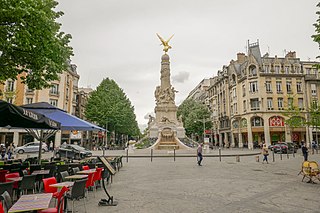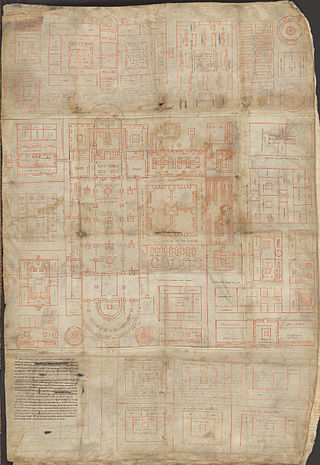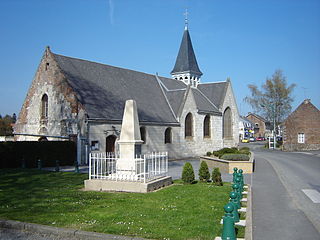
The Abbey of Montier-en-Der in Haute-Marne, France, was formerly a Benedictine, later Cluniac, abbey, dissolved during the French Revolution, the grounds and premises of which, since 1806, have been used as the French National Stud Farm.

The Abbey of Montier-en-Der in Haute-Marne, France, was formerly a Benedictine, later Cluniac, abbey, dissolved during the French Revolution, the grounds and premises of which, since 1806, have been used as the French National Stud Farm.
The monastery was founded in about 670, in deep oak forest [1] on the banks of the river Voire, at a place that at first still carried its Gallo-Roman name of Puteolus ("little well") in the diocese of Châlons-sur-Marne. [2] The site, which must have been an aristocratic Gallo-Roman villa, to judge from the quality of the ivory diptych found at the site in modern times (illustration, below right), was at that time in the borderlands of Champagne just north of Burgundy and west of Lorraine. The founder was the monk Bercharius, later canonized; [3] The extensive site, which was part of Bercharius' inheritance, was in the forest of Der; Puteolus, the monasterium in Dervo became Montier-en-Der, which name also came to be applied to the commune that grew up around this important abbey.
The eighth century was a time of eclipse for this monastic community, and when the monastery reemerges in the ninth it was Carolingian property, given by Louis the Pious to the bishop of Reims, and the house was served by canons rather than monks. A monastic refounding was effected by abbot Hauto (827).
In the early tenth century, the monks were forced to flee Viking attacks. They were re-established by the 930s, when Montier-en-Der accepted the Gorze Reform driven by St. Evre's Abbey, Toul; [4] some years after, Montier-en-Der accepted the Cluniac Reforms.
By the end of the century, the primitive buildings had been replaced; the abbot Adso (960-92) [5] set about rebuilding the ruined church in stone; it was reconsecrated in 998. The severe Carolingian—Romanesque nave contrasts with a Gothic choir illuminated by sixteenth-century stained glass windows. The abbey church retains its sixteenth-century wooden roof, reminding the visitor that not all churches were provided with stone vaulting. The Early Gothic choir is of the twelfth and thirteenth centuries.

The cartulary of Montier-en-Der, assembled in the 1120s at the height of the monastery's prestige and wealth, is a crucial source of information for the history of west Francia; among the genuine charters are a number of forgeries that are equally interesting for the claims that they were intended to support. The charters bear information on popes, kings, and counts, on manorial structures and the obligations of peasant tenants, and on monastic reform.
At the time of the Wars of Religion, Montier-en-Der supervised twelve priories, and the abbey was one of the core benefices in the strategy of Charles, Cardinal of Lorraine, who exercised seigneurial powers over twenty-one villages in the surrounding countryside. [6]
The abbey was secularized at the French Revolution (1790); in 1806 Napoleon established the National Stud Farm (Le Haras National) in the grounds of the former monastery, to breed improved horses for the use of the cavalry. The stud farm structures were rebuilt for more modern functionality during the Second Empire.

Reims is the most populous city in the French department of Marne, and the 12th most populous city in France. The city lies 129 km (80 mi) northeast of Paris on the Vesle river, a tributary of the Aisne.

Lorsch Abbey, otherwise the Imperial Abbey of Lorsch, is a former Imperial abbey in Lorsch, Germany, about 10 km (6.2 mi) east of Worms. It was one of the most important monasteries of the Carolingian Empire. Even in its ruined state, its remains are among the most important pre-Romanesque–Carolingian style buildings in Germany.

The Plan of Saint Gall is a medieval architectural drawing of a monastic compound dating from 820–830 AD. It depicts an entire Benedictine monastic compound, including church, houses, stables, kitchens, workshops, brewery, infirmary, and a special building for bloodletting. According to calculations based on the manuscript's tituli the complex was meant to house about 110 monks, 115 lay visitors, and 150 craftmen and agricultural workers.

Cluny Abbey is a former Benedictine monastery in Cluny, Saône-et-Loire, France. It was dedicated to Saints Peter and Paul.
The Cluniac Reforms were a series of changes within medieval monasticism in the Western Church focused on restoring the traditional monastic life, encouraging art, and caring for the poor. The movement began within the Benedictine order at Cluny Abbey, founded in 910 by William I, Duke of Aquitaine (875–918). The reforms were largely carried out by Saint Odo and spread throughout France, into England, and through much of Italy, northern Portugal and Spain.
Drogo was a Frankish nobleman, the eldest son of Pippin of Heristal and Plectrudis. He was the duke of Champagne from the early 690s.

Adso of Montier-en-Der was abbot of the Benedictine monastery of Montier-en-Der in France, and died on a pilgrimage to Jerusalem. Biographical information on Adso comes mainly from one single source and has come under question, but the traditional biography depicts him as an abbot who enacted important monastic reform, as a scholar, and as a writer of five hagiographies. His best-known work was a biography of Antichrist, titled "De ortu et tempore Antichristi", which combined exegetical and Sibylline lore. This letter became one of the best-known medieval descriptions of Antichrist, copied many times and of great influence on all later apocalyptic tradition, in part because, rather than as an exegesis of apocalyptic texts, he chose to describe Antichrist in the style of a hagiography.

Fleury Abbey (Floriacum) in Saint-Benoît-sur-Loire, Loiret, France, founded in about 640, is one of the most celebrated Benedictine monasteries of Western Europe, and possesses the relics of St. Benedict of Nursia. Its site on the banks of the Loire has always made it easily accessible from Orléans, a center of culture unbroken since Roman times. In 2010, the abbey had over forty monks led by the abbot Etienne Ricaud.

Flavigny Abbey is a former Benedictine monastery, now occupied by the Dominicans, in Flavigny-sur-Ozerain, Côte-d'Or département, France. The monks at this abbey were the original makers of the well-known aniseed confectionery Anise de Flavigny.
Saint Bercharius was abbot of Hautvillers in Champagne. Descended from a distinguished Aquitanian family, he received his instruction from Saint Nivard (Nivo), Archbishop of Reims.
The Abbey of St. Evre was a Benedictine, later Cluniac, monastery in Toul, France. Established in or just before 507, it was the oldest monastery in Lorraine and of great significance in the monastic and religious reforms in the Rhine and Moselle region of the 10th and 11th centuries.

Homblières is a commune in the Aisne department in Hauts-de-France in northern France.

Arcis-le-Ponsart is a commune in the Marne department in northeastern France. It is located along the D25 road, south of Courville, 32.2 kilometres (20.0 mi) by road southwest of Reims. The commune of Arcis-le-Ponsart has an area of 15.4 square kilometres (5.9 sq mi). The local economy is mainly agricultural based. Igny Abbey lies in this commune.

The Symmachi–Nicomachi diptych is a book-size Late Antique ivory diptych dating to the late fourth or early fifth century, whose panels depict scenes of ritual pagan religious practices. Both its style and its content reflect a short-lived revival of traditional Roman religion and Classicism at a time when the Roman world was turning towards Christianity and rejecting the Classical tradition.
Molesme Abbey was a well-known Benedictine monastery in Molesme, in Laignes, Côte-d'Or, Duchy of Burgundy, on the border of the Dioceses of Langres and Troyes.
Adso may refer to:
Montier may refer to:

Saint-Maur Abbey, originally called the Abbaye des Fossés, is a former abbey now subsumed in the Saint-Maur-des-Fossés suburb of Paris, France. The remains and the domain of the abbey have been transformed into a pleasure park named Parc de l'abbaye. The former abbey building has been replaced by a square at the corner of Avenue de Condé and Rue de l'Abbaye. Some ruins remain, such as the Rabelais tower, the 19th century Bourières villa and the old fortifications. The remains of the abbey have been classified as historical monuments since 13 June 1988.

Saint-Thierry Abbey was formerly a Benedictine abbey in the village of Saint-Thierry, Marne, It was closed in the 17th century and razed to the ground during the French Revolution. Since 1968 it has been a Benedictine nunnery in the Archdiocese of Reims.
Walter I of Brienne, was a count of Brienne and Bar-sur-Seine. He was the son of Engelbert IV of Brienne, count of Brienne, whom he succeeded. He attended the council of Senlis in 1048 and was excommunicated in 1082.